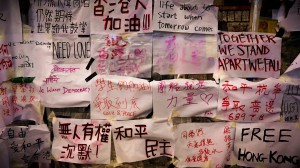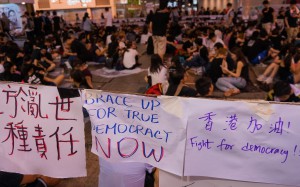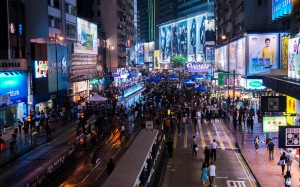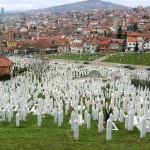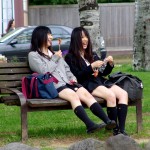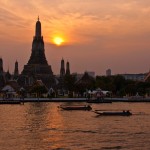I’ve been getting a lot of questions about the protests in Hong Kong lately (some worried, some curious), so I decided to write down some of my impressions of the situation here.
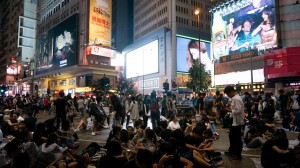
So what’s the background to all of these protests? In 1997, Britain gave back its colony Hong Kong to China, under the agreement that Hong Kong would have a great deal of autonomy for at least 50 years, under the “One Country, two Systems” policy. At that point, Hong Kong’s new constitution (the Basic Law) came into force, in which universal suffrage was stated as the future “ultimate aim.” So far, Hong Kong has been led by a Chief Executive (currently Chun-Ying / CY Leung), chosen by an election committee of 1200 members, the majority of which are pro-China. However, China had stated that Hong Kong citizens would get a direct vote in the next Chief Executive elections in 2017. Now, the wording of this promise seems to be reinterpreted by China, with heavy debate arising over what the Basic Law stipulates: one-person one-vote, or not? To ensure electoral reform would be in accordance with the wishes of the Hong Kong public, a protest group formed, called “Occupy Central with Love and Peace” (referring to Central, Hong Kong’s business district and the heart of Hong Kong Island). Earlier this summer, Occupy Central organized an unofficial referendum, in which voters could nominate their preferred direct-vote elective system. One in five registered voters turned up at the referendum, a number exceeding expectations. At that time, Occupy Central organized protests on Hong Kong Island, but these were equally followed by a massive pro-China, anti-Occupy rally.
A decisive moment came when China’s national government announced its ruling on the matter on 31 August: direct suffrage will be granted to Hong Kong citizens in 2017, but they may only pick from a list of 2 or 3 pre-approved candidates, which will need the backing of a nominating committee. It is widely expected that this committee will be quite pro-China, thus effectively weeding out candidates that are opposed to Beijing or seen as too democratic. China justified its decision by explaining that Hong Kong was “confused” over its rights and autonomy, and that China thus needed to make sure any Chief Executive candidate would “love his country.” The Hong Kong government still needs to debate Beijing’s ruling and pass a bill of its own on the issue, but it is against this backdrop that the current unrest (even: revolution) has been unfolding in Hong Kong.
Protests started relatively small, but turned serious on 22 September, when over 13 000 students in the city boycotted classes for an entire week. After that, students turned to the Central district on Hong Kong Island, where they started a peaceful sit-in around the main government offices. Riot police arrived on the spot: last Sunday night, they repelled the protesters by teargas, pepper spray and force. This caused massive outrage in Hong Kong, especially as the protesters were seen as incredibly peaceful. Compared to other protests in history around the world, no looting, damage to surrounding buildings/vehicles or rioting has occurred. So as a result, even more people joined the students, including the Occupy Central movement. They had long announced that they’d start a major “campaign of civil disobedience” on 1 October, but decided to come out earlier to join the students’ momentum. (This action has been criticized by several who say Occupy Central is hijacking the students’ movement, and that the two campaigns need to be seen as separate.)
What is the situation like on the ground right now?
I can honestly say that I have almost never seen crowds like this in my entire life. You have probably all come across the pictures in newspapers, but the sheer size of the masses is insane. When you now stand outside a subway exit at night, people just keep streaming and streaming and streaming out, endlessly. Most of them seem quite young: late teens, or 20- and 30-somethings. They are determined but cheerful, all defiantly wearing the protester’s uniform: a black t-shirt and yellow ribbon proudly pinned to their chest. When I followed them down to the very core of the protests, my jaw simply dropped. All I could do, was mutter “Ho-ly crap.” As far as my eye could see, on all the roads, overpasses, bridges, sidewalks and parks underneath the towering skyscrapers, people were amassing. Like ants, they were simply everywhere. It was an awe-inspiring, exhilarating sight!
Basically these protesters have brought some of the most important roads of Hong Kong Island to a standstill, blocking the areas of Admiralty and Central with barriers and crowds. On normal days, mad traffic congests these busy roads – but when I walk to work now, I’m greeted by an almost Armageddon-like view of empty roads, save for a couple of office workers in the morning. At the protest sites themselves, things vary quite a bit from moment to moment though: the crowds are biggest in the evenings after work, and diminish during the day. Protests have spread to other parts of the city too: now sit-ins are organized on Kowloon side across the harbour, and roads are blocked eastwards in Causeway Bay. When I joined the protests some evenings ago, I could walk right in the middle of the street for almost twenty minutes, all the way from these Causeway Bay protests to the Central core. The feeling was very strange: no traffic, and instead people strolling arm in arm, taking selfies to capture the surreal situation. Yellow ribbons are tied to lamp posts and fences everywhere along the protest roads. Handwritten signs are taped to buildings and overpasses – not only in Chinese, but even in Russian, English, Swedish or French. Slogans talk about democracy, revolution and rights, but mostly in a peaceful manner: dreaming big, asking with outstretched hands, standing together. The only signs that are somewhat ‘offensive’ are printed photos of CY Leung, the reviled Chief Executive, with fangs and devil horns scribbled on his face, and messages of “CY go home!” or “Resign!”
What newspapers report about the polite and friendly manner of protesters is very true, by the way. A short walk from my apartment, I came across the first protesters sitting on the street. I didn’t have a yellow ribbon yet, so I spoke to two women who were just pinning theirs on. When I asked them where they got it, one of them instantly took her ribbon off and said “Here, I give this to you! You support our struggle!” with a broad smile and a raised fist. At the core protest site, I was surprised by how calm everybody behaved: nobody was shoving, pushing or shouting at others. Nobody seemed drunk nor did I see any alcohol. Instead, there were boxes with biscuits, bananas and water bottles everywhere, all handed out for free by volunteers. You hardly needed to ask – people just offered you food, mouth masks or rain ponchos. There was barely any trash lying around at the protest sites, because protesters have devised a solid system of trash collection…and recycling! This recycling part is especially astounding, because Hong Kong usually recycles extremely little. Another very touching gesture was the fact that people helped each other a lot. Along the protest sites, there are some pretty big barriers of concrete blocks which are somewhat difficult to clamber across. What the protesters did, was create a makeshift staircase of cardboard boxes and bags, and then they formed a chain of people who gave you a hand and made sure you got across safely. I was at the protests with a couple of Chinese girls wearing skirts, and the guys near the barrier even showed them how to cross in a comfortable way that wouldn’t lift up their skirt. Amazing! So people are all smiles and friendliness, a mood I hadn’t expected from such large protests.
Other than this, it’s difficult to describe the nature of the protests. Personally, I had expected more, well: protesting. My impression was that these tens of thousands of people showed up, but then most of them ended up just walking around or sitting together peacefully while chatting, but that was it. This could be because I don’t speak Cantonese, though: perhaps to me, the verbal protesting is less obvious. Several groups of people were singing pro-democracy songs, for example, and a lot of them held up signs in Cantonese, with several activists standing on a barrier with a microphone, addressing part of the crowd. But there wasn’t one main figure addressing everyone, nor did there seem to be any direct leadership or one single program everyone was following. I wonder to what extent this was just my feeling, as a foreigner, or whether some of the locals joining in had the same experience. Sometimes I saw some people taking pictures of themselves in front of the crowds, which smacked the teensiest bit of revolution-tourism. But don’t get me wrong: it is encouraging to see so many people out on the streets, fighting for something they believe in. They are undoubtedly passionate about better governance and universal suffrage in Hong Kong. But as one American I talked to said: “Perhaps they still have to figure things out a bit, as Hong Kong has a shorter history of revolution than some other countries. So maybe this is newer to them and it takes a while to figure out the most effective way to protest.” Maybe there’s some truth to what he said.
It’s difficult to know too how broad the support base is for the protests amongst Hong Kong locals. One colleague calls them “that rubbish going on in Central,” as she’s skeptical about protesters’ knowledge of what the whole background is about. Other critics include businesses in Hong Kong, who fear declining profits, and citizens who are annoyed by the disturbance the protests have caused, especially transport-wise. When I was on my way to the protests, I looked at other passengers on the subway: some in black with yellow ribbons, but others just chattering happily, walking around ready for a night on the town. Do these people think a lot about the protests? Have they gone to take a look? Are they supportive? Or do they feel annoyed? I want to find out more.
I talked to some other people in Central too, including the two Mainland Chinese girls I was with: both of them are students in Hong Kong, and I was surprised by how fearful they seemed of being at the protests. One of them even covered her face with a mask non-stop, saying she didn’t want anyone to recognize her. One described how her parents had received an official call in China to inquire into their daughter: where was she in Hong Kong, what was she doing, surely she wasn’t joining these illegal protests? In a tiny voice, she told me that she had mainly come along that evening because her friend wanted her to go, and that she definitely wouldn’t tell her parents. Her friend seemed only slightly more comfortable, but she too told me that she worried about her parents’ job with the Chinese government, in case word got out of their daughter’s whereabouts. Laughing nervously, she said: “I almost feel like I’m coming out as a lesbian here, that’s how big of a deal this is to me!”
Another mainland Chinese guy visiting a friend of mine, seemed very uncomfortable when I asked him about the protests. I wondered whether he would join. He laughed, said “Hmmmm. I’m not so into politics” and left it at that. It reminded me of a sentence I read last week, in a book on China by Paul Theroux: “The Chinese laugh is seldom a response to something funny – it is usually Ha-ha, we’re in deep shit or Ha-ha, I wish you hadn’t said that or Ha-ha, I’ve never felt so miserable in my life.” I understand what he means now.
Finally, what’s coming next? The short answer to that is: nobody knows, since the situation is so unlike what Hong Kong has seen for the past couple of years. I’ve been receiving worried e-mails from people wondering whether the Chinese army will step in and we will see another Tiananmen Square. Personally, I don’t think things will progress that far: Hong Kong is a very international, modern city, and an important node in the global economy. The eyes of the world are on the events here, so China could do enormous damage to its image and diplomatic relations if it let the army loose on these unarmed students. On the other hand, unrest in Xinjiang has been getting worse lately, so the Chinese government is probably weary of having another revolution hotbed on its hands, nor do they want to lose face or be perceived as weak.
The Hong Kong government’s response has also been disappointing so far: very little direct contact with the protesters, just speeches by CY Leung saying he refuses to step down, and now some kind of half-hearted offer for talks between the students and Chief Secretary Carrie Lam. Some fear the Hong Kong government is trying to wear out the protesters: dithering until they go home of their own accord. Simultaneously though, police vans delivered large boxes of what appeared to be tear gas, pepper spray and batons to the government headquarters yesterday, perhaps preparing for a more direct confrontation.
The most realistic remarks I have heard about the protests, were made by a young man at the Hong Kong Arts Centre, with whom I’ve been working together closely. He told me that he felt there was very little chance of the protesters achieving their aims (i.e. CY Leung stepping down, and real universal suffrage). “It’s a bit sad that this will probably not happen, yes. Because imagine if you asked your mother whether you could pick your boyfriend, and she replied: ‘Sure! You can date whoever you want! But he needs to be a guy from the pre-selected list I drafted.’ That’s ridiculous and not okay. That’s why we want to be able to pick our Chief Executive. But the main achievement of these protests will be something else: we will finally have created a discussion. We have raised the issue, and now people are talking. That’s the most important start.”

